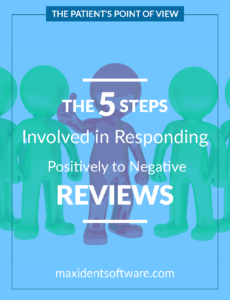[vc_row][vc_column][vc_column_text]
Welcome back to part two of responding to negative reviews. As I have gone through the big-time no-no’s of responding negatively, it’s now time to focus on positive responses and the steps dental professionals should consider taking before sitting down to write. Again, this will require you to take your dental professional’s cap off to join me on this journey. This will also require you to remember and maybe even bring up your patient review and your response to that patient review.
I want to ask a crucial question right now and I need you to be honest with yourself. When you look at or remember the response to your patient review, how does it make you feel? Remember, you are now that patient. Do you feel better about the practice or do you feel like something is missing? Does the response sound angry or defensive? Creating a positive response to a negative review is difficult if you’re not in the right headspace and can cause a lot more problems for your practice. In this blog post, we are going to explore the steps involved in getting you into the right headspace to write an effective and beneficial response that is not soaked in emotion or unhelpfully defensive. We are also going to look at the types of positive responses other health professionals have used to yield positive results for their practice. At the end of this journey, I would hope that you will take a second look at your own response again and see if there are ways in which you can make it better or make the message clearer.
First thing’s first, everyone has the right to free speech
This is not step one. This is the step before step one because you can’t even begin to think about your response without understanding this very fundamental right– the right to free speech– and doing anything to eliminate that voice will not bode well for you or your practice. In an article posted on news.nationalpost.com, patients admitted to turning to “rating sites for closure and in the hope that their experiences would help others seeking care.” And what happened when their dental professionals responded negatively? They damaged the cornerstone of the patient-doctor relationship by leaving those patients “with a lingering sense of lost trust.” Patients deserve to have a voice. Trying to edit or silence that voice is almost guaranteed to hurt your practice down the road.
Step 1: Breathe
Are you in the right frame of mind? Or are you responding with lingering anger and betrayal? Whatever you feel will be reflected in your writing. You can’t hide emotion as is the case with those negative reviews you might be faced with. First thing’s first. Step back and breathe. Anger is a passing emotion so let it pass. Don’t let rational thought take a backseat to anger.
Step 2: Remember that all reviews are valuable
Jeffrey Segal, a onetime critic of review sites, offers this piece of sage advice about negative reviews: “Doctors need to embrace them.” But don’t think of the review you’re embracing as a negative review, think of it as a review with valuable feedback that you can now use to improve and benefit your practice.
Step 3: Practice empathy
You’re the patient now, right? The cap is off and you are donning another one, the cap belonging to that angry reviewer. This is empathy at its best, and it’s important to practice this with all your patients to better understand and effectively serve their needs.This is also helpful not only to find out what’s really going on with your patient but to get you in the right frame of mind with your response.
Step 4: Identify the problem
As I’ve mentioned before, I’m not a customer service novice. I’ve seen it all and have been through the wringer with difficult customers, but I have learned that one of the most crucial aspects to forming a truly beneficial response is being able to identify the problem first. Practicing empathy will help you achieve this goal. But sometimes it’s not so easy especially with emotions raging. It’s the same in a written review. You will find a lot more emotion than you will a straightforward reason for that anger. It is your responsibility as this patient’s dental professional to discover the real problem by digging through the emotion. Until you do, you can’t address it properly or really at all.
Step 5: Stay Positive
Now that you’ve gone through all the steps required to really start writing an effective response, it’s time to suss out what that response might be. Don’t use a blanket apology, but do “apologize for any perceived slights.” You don’t want to put your practice under the microscope by sending a blanket apology. Once you’ve discovered what the issue is, your best form of apology is addressing that issue and asking the patient what you and your team can do to make the proper improvements. Let them know they can contact you offline or take it a step further and let them know that you or a member of your team will contact them as soon as possible to sort out the issue. Make yourself available and create a bridge to recovery for both of you. In a slight detour, don’t forget to encourage patients who are satisfied to post positive reviews. Click to Tweet
Conclusion
The trick to responding rationally and with empathy is to take a breather between reading and responding. You might be angry at the time, but anger is a passing emotion. Let it pass and when it does, read the review again. Don’t be emotional. Be empathetic, because at one point either before or in the future, this review could be yours. Look at it as valuable feedback rather than something negative. It’s time to examine that review you wrote again. What improvements can you make to your response? It’s important that you never publish the first draft as it is usually riddled with errors and laced with emotion. Read it over at least twice and publish only when you’re sure of its benefits to both your patient and your practice.
Next week, take your caps off and join me to start a journey to better understanding how the attitudes of your team affect your patients.
Resources
- http://www.nydailynews.com/new-york/manhattan/manhatOk tan-dentist-sues-5-patients-4-years-bad-reviews-article-1.2726895
- http://www.dailymail.co.uk/news/article-2934801/Patient-posted-bad-review-dentist-Yelp-sued-125-000-practice-legal-slammed-poor-substitute-customer-service.html
- http://news.nationalpost.com/health/doctors-fire-back-at-bad-yelp-reviews-and-reveal-patients-information-online
- http://time.com/money/4426383/dentist-sues-patients-online-reviews/
[/vc_column_text][/vc_column][/vc_row][vc_row][vc_column][ultimate_spacer height=”50″][vc_raw_html]JTNDZGl2JTIwY2xhc3MlM0QlMjJzaGFyZXRoaXMtaW5saW5lLXNoYXJlLWJ1dHRvbnMlMjIlM0UlM0MlMkZkaXYlM0U=[/vc_raw_html][ultimate_spacer height=”50″][ult_createlink title=”Big Time No-No’s for Responding to Negative Reviews – Part 1″ btn_link=”url:http%3A%2F%2Fmaxidentstaging.mystagingwebsite.com%2Fbig-time-no-nos-for-responding-to-negative-reviews%2F||target:%20_blank|” text_color=”#0ab2cc” text_hovercolor=”#171177″ text_style=”left”][/vc_column][/vc_row]



